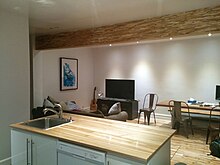Parallel-strand lumber


Parallel strand lumber (PSL) is a form of engineered wood made from parallel wood strands bonded together with adhesive. It is used for beams, headers, columns, and posts, among others uses. The strands in PSL are clipped veneer elements having a least dimension of not more than 0.25 inches (6.4 mm) and an average length of at least 300 times this least dimension.[1] It is a member of the structural composite lumber (SCL) family of engineered wood products.[1]

The design strength of PSL is greater than that of sawn lumber made from the same species because knots and other imperfections are randomly dispersed throughout the product. As a result, strength variability from one piece of PSL to another is less than in solid-sawn wooden beams. Since materials are commonly graded to the lowest 5th percentile of the material's strength curve, this gives PSL much higher usable values for bending, tension parallel to grain, and compression parallel to grain.
Parallam is the brand name for the product invented, developed, commercialized and patented by MacMillan Bloedel (now Weyerhaeuser). It is the world's only commercially manufactured and marketed parallel strand lumber product.[citation needed] PSL can be made from any wood species, but Douglas-fir, southern pine, western hemlock, and yellow-poplar are commonly chosen[2] because of their superior strength.
The product is manufactured as a 12" x 12" or 12" x 18" billet in a rectangular cross-section, which is then typically sawn and trimmed to smaller cross-sectional sizes. The beams are continuously formed, so the length of the beam is only limited to the maximum length that can be handled and transported. Typical widths are 3½", 5¼” or 7"; typical depths are 9½", 11⅞" 14", 16" & 18". Typically the beams are made to a maximum length of 60 feet.[3]

References
- ^ a b 2012 International Building Code. Country Club Hills, Ill: ICC. 2011. p. 36. ISBN 1609830407.
- ^ Stark, Nicole M.; Cai, Zhiyong; Carll, Charlie G., eds. (2010). Wood Handbook. Madison, WI: Forest Products Laboratory. pp. 11–21.
- ^ Kam-Biron, Michelle; Koch, Lori (Oct 2014). "The ABC's of Traditional and Engineered Wood Products". Structure Magazine.
